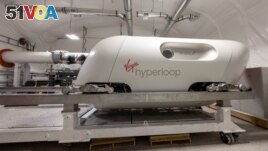The head of the Virgin Hyperloop transport system says the company aims to begin carrying passengers by 2027.
Josh Giegel helped start the company and is its chief executive officer. He made the comments to a Reuters reporter at the company’s development and testing center near Las Vegas, Nevada.
The Virgin Hyperloop system is based on a technology called magnetic levitation. It uses magnetic fields to lift a vehicle off the ground a little and to push it forward.

A prototype hyper loop pod is seen at the Virgin Hyperloop facility near Las Vegas, Nevada, on May 5, 2021. (REUTERS/Mike Blake)
Some high-speed trains also use this technology. But unlike trains, a Hyperloop is designed to operate within tubes containing very little air. Electric propulsion moves vehicles, called pods, through the tubes at high speeds. The system offers nearly silent travel and reportedly releases no carbon emissions.
Last November, Giegel rode inside a Virgin Hyperloop pod along with another company official during the system’s first test with passengers. The company said the vehicle reached a top speed of 172 kilometers per hour in that test.
But Virgin Hyperloop says the system’s pods are designed to move at much higher speeds, up to 1,200 kilometers per hour. It says such a vehicle could complete a trip between New York and Washington, D.C. in 30 minutes. That would be two times as fast as a jet flight and four times faster than a high-speed train.
“It will feel like an aircraft at take-off and once you’re at speed,” Giegel told Reuters. “You won’t even have turbulence because our system is…completely able to react to all of that turbulence.”
The pods will seat 28 passengers and could be specially designed to travel long or short distances, or to carry goods, the company said.
While the system is still in early development, Giegel predicted that commercial operations could start as early as 2027. Virgin Hyperloop is looking to first develop passenger systems in India, where the transport system is overcrowded, and in Saudi Arabia, which lacks infrastructure.
Giegel said it could be the first form of transportation in 100 years to revolutionize travel, as cars, trains and airplanes did before. “It starts off with two people riding a Hyperloop. It ends with hundreds of millions of people riding on a Hyperloop and that’s what the 2020s – the roaring 20s – will be,” he added.
Virgin Hyperloop has partners that include Virgin Group founder Richard Branson and the port operations company DP World, which is owned by the Dubai government.
I’m Bryan Lynn.
Bryan Lynn wrote this story for VOA Learning English, based on reports from Reuters and Virgin Hyperloop. Mario Ritter, Jr. was the editor.
We want to hear from you. Write to us in the Comments section, and visit
__________________________________________
Words in This Story
levitation – n. making something rise into the air
propulsion – n. the force produced by a system for moving, or propelling, a vehicle
emission – n. the act of producing or sending out something (such as energy or gas) from a source; something that is sent out or produced by something
commercial –adj. concerned with earning money
turbulence – n. an unsteady or violent movement of air or water
infrastructure – n. the basic equipment and structures (such as roads and bridges) that are needed for a country or region
roaring – adj. very load active or strong